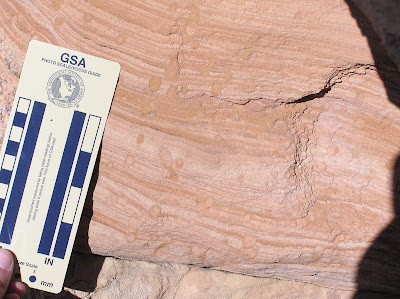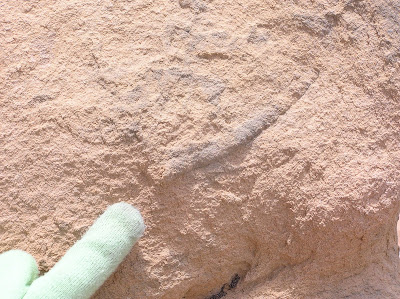
Ichnology, from the root word ichnus, meaning "trace," is the study of trace fossils. Traces are what's left behind by living organisms. They could be burrows, footprints, trails, borings in wood (or rock or shell or bone), an impression left where an animal rested, or even tooth marks. Above, you can see a footprint left by a three-toed creature from the Triassic. In many ways, ichnology is more exciting than regular paleontology, as you are not just looking at the bones of a dead thing, but at where the living animal walked and what it did.
 A trackway showing several three-toed prints.
A trackway showing several three-toed prints.Since it is impossible to know for sure what kind of animal made each ancient trace, we don't speak of Ankylosaurus tracks or shrimp burrows, but instead give each kind of trace its own scientific name and classification; its own ichnotaxon. One variety of burrow is named Ophiomorpha (meaning "snake-shaped"), and it is similar to the burrows made by modern shrimp; one type of track I have seen this summer is called Brachychirotherium ("short-handed beast"), and it may have been made by aetosaurs.
Ichnology is informed by neoichnology, the study of modern traces. If you happen to live near sand or mud, then you are surrounded by traces. Here are some I have seen in the park this summer. You may distinguish the bird, mammal, reptile, and insect traces. Click pictures for detail.





 Unlike body fossils, which are best preserved by being buried quickly, tracks seem best preserved if buried slowly. A dinosaur may walk across a damp sandbar in a river; if the sand is fine-grained, or has some mud in it, the tracks may show up nicely. They may dry out a little and start to harden, before the rains come, the river rises and slowly more sand or mud is deposited on top of the tracks. (To learn more about dinosaur tracks, check out this very interesting site.)
Unlike body fossils, which are best preserved by being buried quickly, tracks seem best preserved if buried slowly. A dinosaur may walk across a damp sandbar in a river; if the sand is fine-grained, or has some mud in it, the tracks may show up nicely. They may dry out a little and start to harden, before the rains come, the river rises and slowly more sand or mud is deposited on top of the tracks. (To learn more about dinosaur tracks, check out this very interesting site.)It is not always easy to find, or recognize, trace fossils. Often we must look on the underside of ledges, for the "negative" of a footprint, made from the sand that washed into the print after it was made:

And some traces are impossible to see unless you know what you're looking for.
 These are Brasilichnium ("trace from Brasil") tracks, made by a mammal-like reptile walking up a dune face. We know they are tracks because of the "push-up," or crescent of sand behind them that modern trackmakers also leave. (Click here to see some better Brasilichnium tracks.)
These are Brasilichnium ("trace from Brasil") tracks, made by a mammal-like reptile walking up a dune face. We know they are tracks because of the "push-up," or crescent of sand behind them that modern trackmakers also leave. (Click here to see some better Brasilichnium tracks.)The Navajo Formation, where I am working, was formed in an erg, or sand sea, one superficially like the modern Sahara. There are not a lot of creatures in the Sahara--at least, not, say, as compared to the Amazon rainforest, or even your backyard. So there are not a lot of traces. Most of what we've found are arthropod burrows. They are distinguished by how they cut across the bedding of the sand in which they're found:


 The first two were, perhaps, made by beetle or fly larvae feeding in the sands. The third may have been a spider or scorpion burrow.
The first two were, perhaps, made by beetle or fly larvae feeding in the sands. The third may have been a spider or scorpion burrow.Some burrows can be seen right on the top of a bed, and may contain "menisci" made by a creature pushing sand behind it as it tunneled:
 And some burrows may be seen in relief as the sand weathers:
And some burrows may be seen in relief as the sand weathers: But so far, the only tracks I and my partner have found have been the tracks of arthropods (perhaps spiders)--no dinosaurs, no early mammals. They are shown here:
But so far, the only tracks I and my partner have found have been the tracks of arthropods (perhaps spiders)--no dinosaurs, no early mammals. They are shown here:

In the second, only the orangish stripe was exposed above the sand, and I saw some dots on it. scraping the sand away revealed a trackway.
So what good is ichnology? Dinosaur or mammal tracks can tell us about stride length, and possibly whether dinosaurs traveled in herds, but probably the most useful aspect of ichnology is the study of invertebrate traces. Since scorpions or shrimp or worms can't travel great distances, we know that they belonged in whatever environment we find their traces in, and thus they allow us to infer a great deal about the environments in which different rocks were deposited. This adds to our knowledge of previous environments and climates on our continents, and also helps the oil industry find oil.

 Here, we help a team from the university carry out a slab with traces on it made by a swimming reptile.
Here, we help a team from the university carry out a slab with traces on it made by a swimming reptile.Nothing I've found this summer has been at all spectacular, sadly, and the nicest things weren't even in the formation I'm supposed to be working in, but from the Chinle Formation, which was formed in a river system and had a lot more things living in it.
 Very small tracks, presumably from an arthropod! That is my compass in the corner.
Very small tracks, presumably from an arthropod! That is my compass in the corner. Very nicely preserved burrows.
Very nicely preserved burrows. Lizard footprints. There are three of them in the picture, though they are a bit difficult to see.
Lizard footprints. There are three of them in the picture, though they are a bit difficult to see.You my readers, who are mostly Connecticut and Denver, have wonderful places to view dinosaur tracks close to home. Dinosaur State Park in Connecticut and Dinosaur Ridge in Morrison are both world-class sites and enjoyable day trips.
Till next time!

1 comment:
Thanks for the information on Ichnology, something I didn't know existed.
However, upon thought of my oceanside treks,I realize I have seen many such traces.
Love,
Mom
Post a Comment